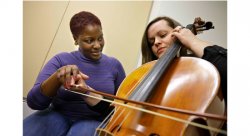The Healing Power of Music Therapy
Posted in: Cali News

Music therapy has played a remarkable role in the rehabilitation of Congresswoman Gabrielle Giffords, who suffered a serious brain injury after being shot in the head in January 2011 while meeting her constituents in Tucson, Arizona, and put a spotlight on this established, yet still developing, profession.
Montclair State University’s Music Therapy program, introduced in 1970, is one of the oldest and foremost training programs in the country, and is the only Music Therapy academic program in New Jersey. In an article on the history and development of the University’s Music Therapy program for the American Music Therapy Association’s newsletter, Music Therapy Professor Karen Goodman, who served as director of the Music Therapy program for over two decades and designed and instituted the graduate program in 1998, includes the reflections and remembrances of former students and faculty in chronicling the scope and continuing success of the program.
Approximately 60 students are enrolled in Montclair State’s bachelor’s degree program and 25 in the master’s degree program at the John J. Cali School of Music. “Our numbers have gone up about 40 percent in the last year,” reports a pleased Brian Abrams, associate professor of music and coordinator of the Music Therapy programs.
Of last year’s degree recipients in music therapy at Montclair State, nearly all found jobs within their field shortly after graduation.
Music therapy involves the use of music and musical activities to accomplish therapeutic goals: to restore, improve, or maintain mental and physical health. “Music therapists work with clients of all ages, from infants to the elderly,” says Jane Creagan, director of professional programs at the American Music Therapy Association (AMTA), based in Silver Spring, Maryland. “Music therapists work with a wide variety of populations, from working with mothers to ease the pain of labor and delivery to serving seniors in hospice care with end-of-life transition and bereavement.”
Music as a healing influence gained prominence as a field following World War I and World War II when community musicians went to veterans hospitals around the country to soothe returning soldiers who suffered from both the physical and emotional trauma of war.
Today, music therapy practitioners work in a diverse range of settings—hospitals, schools, hospices, clinics, nursing homes, community mental health centers, prisons, psychiatric institutions, and in private practice. They help people deal with issues such as depression, pain management, stress reduction, socialization, physical rehabilitation, and conflict resolution, among others.
Live music is a central aspect of music therapy, and patients are encouraged to take part in the act of music making. “You must be a musician to be a music therapist—not that you can’t utilize recordings, but if you do, you utilize them with clinical intention, and with the musical and artistic sensibility that you cultivate as a musician,” explains Abrams.
All styles of music are employed, from classical to doo wop. “There is a lot of give and take. The therapist plays, the client plays, music is pre-composed, music is improvised. It’s every possible manifestation of how we experience music,” he adds.
At a recent music therapy session for pre-school children on the autism spectrum, held at the College of Education and Human Services’ Ben Samuels Children’s Center in Little Falls, five children sang, drummed, and played a xylophone-like instrument called resonator bells, while Montclair State-trained music therapist Amy Clarkson and music therapy intern Paul Kates guided the children through musical exercises designed to promote speech and language expression, as well as awareness of and interaction with each other.
“Most kids on the spectrum have delays in communication skills. Music can help them find their voice,” says Clarkson. “What we want the kids to do is find a way to access the world where they can be part of it rather than feel that they need to separate themselves from it. Music provides a container, a structure that helps them feel comfortable.”
Music therapists also work in conjunction with psychiatrists, psychologists, physical therapists, occupational therapists, and speech and language pathologists, among others. “Very often, we collaborate in teams,” says Abrams. “This is one of the great assets of our field.”
The training of a music therapist is a unique combination of courses in music, psychology, and music therapy. Music constitutes about 65 percent of the curriculum. Students must achieve functional competency in piano, voice, and guitar, while also continuing to develop their expertise in their primary musical instrument. “A student’s musical, aesthetic, and artistic development is paramount,” Abrams says.
The approximately 120-credit, 4.5-year bachelor’s degree curriculum culminates with a supervised six-month clinical internship. Graduates of the program are eligible to become a Board Certified Music Therapist through the Certification Board for Music Therapists. The master’s degree program, begun in 1998, consists of 2-4 years of coursework, including a thesis.
Molly Wilkerson, a 20-year-old music therapy major from Maryland and co-president of the Music Therapy Student Organization, specializes in classical singing. She finds that working as a music therapist has helped close the gap between her and an audience. “I love the contact I can get with other people,” she says. “If I was performing and people were sitting in an audience, there would be that distance. Music therapy allows you to sit right next to a client. I enjoy that connectedness.”
